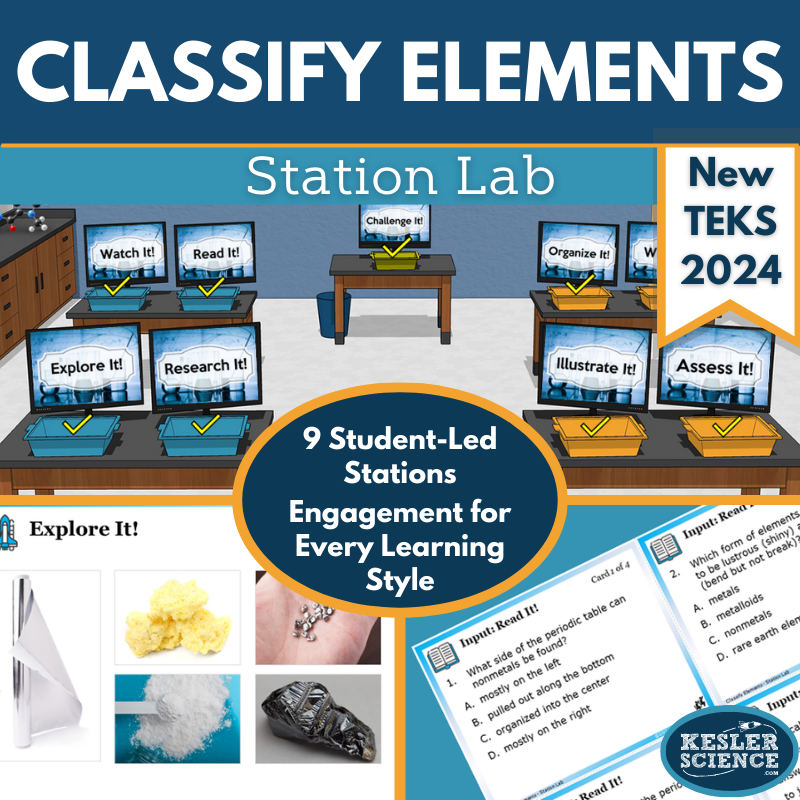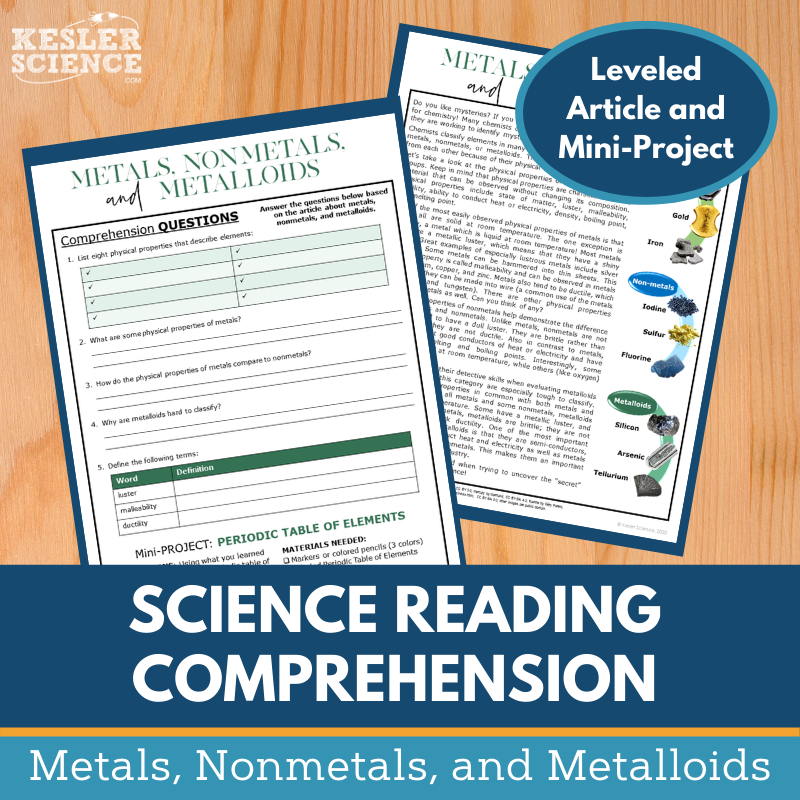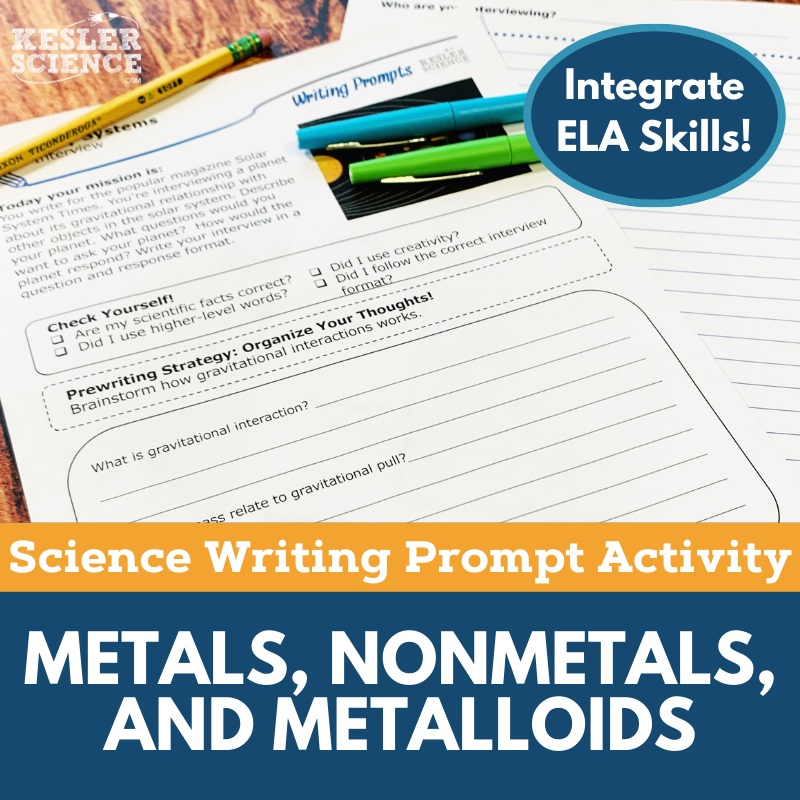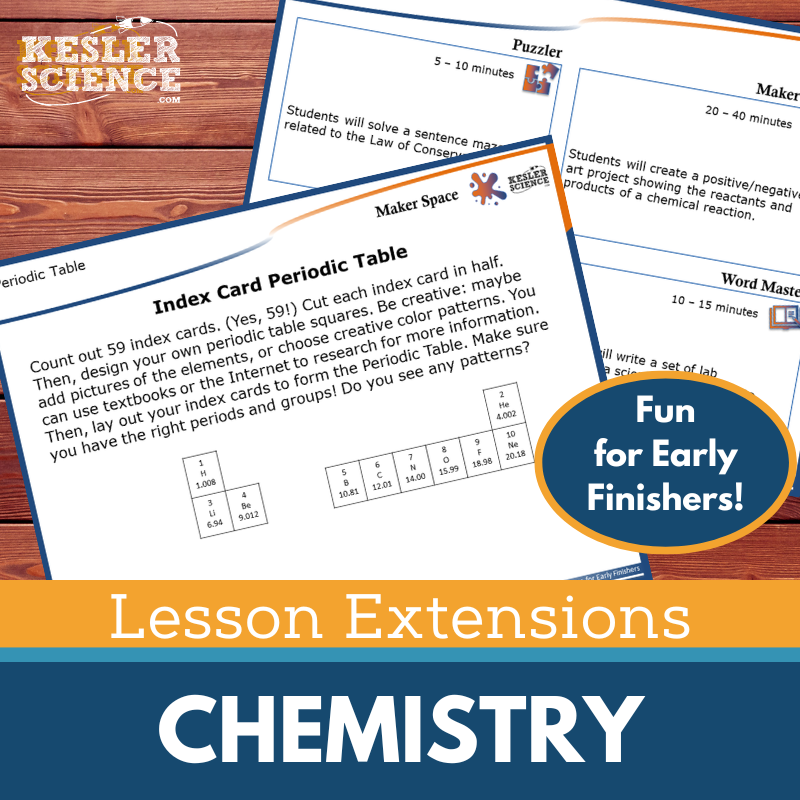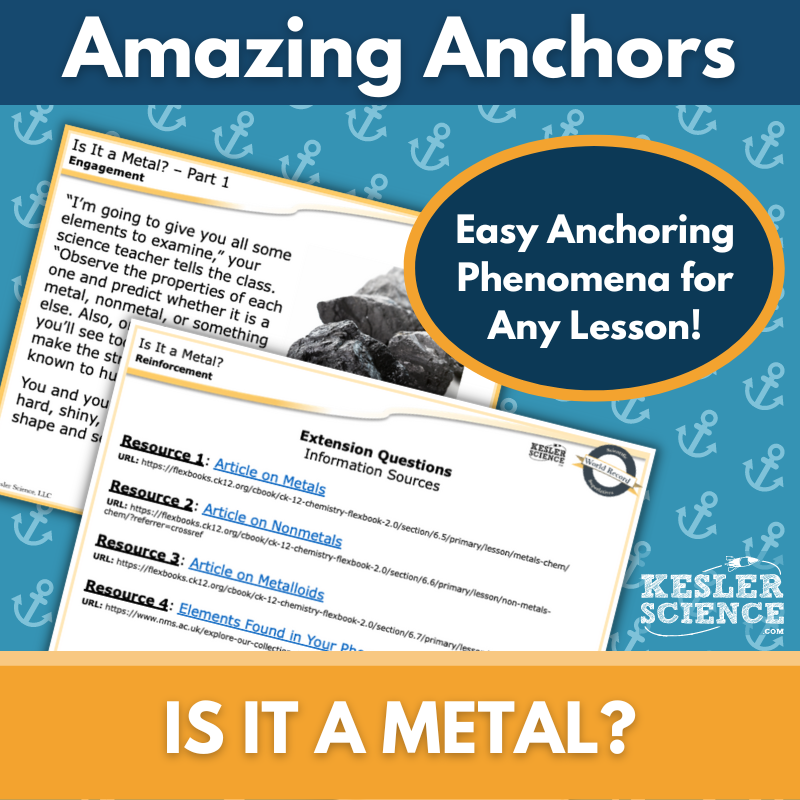Classify Elements Activities for Middle School Science
Mastering the classification of elements is made easy with this engaging 5E lesson! The resources below will give students a comprehensive understanding of classifying elements. All of the following materials are also included in the Kesler Science Membership.
The Kesler Science Classifying Elements 5E Lesson is a comprehensive middle school chemistry unit designed to help students classify elements on the periodic table as metals, nonmetals, and metalloids based on physical properties. The lesson includes editable PowerPoints, worksheets, student-choice projects, assessments, and multimodal, differentiated resources for student-led learning. It is fully aligned with the 2021 TEKS 6.6C standard and offers Spanish translations for key materials.
Students engage with vocabulary and objectives before exploring the periodic table through a hands-on, differentiated station lab. With nine stations, students interact with content through reading passages, research tasks, videos, experiments, and creative exercises. The lesson features editable presentations, interactive notebooks, and note-taking templates to reinforce concepts. Elaboration activities include student-choice projects, while assessments aligned with STAAR 2.0 ensure mastery.
Designed for flexibility, the lesson supports both in-person and virtual learning, offering printable and digital formats. The structured 5E approach—Engagement, Exploration, Explanation, Elaboration, and Evaluation—ensures deep understanding and retention.
The Kesler Science Classifying Elements 5E Lesson is a comprehensive middle school chemistry unit designed to help students classify elements on the periodic table as metals, nonmetals, and metalloids based on physical properties. The lesson includes editable PowerPoints, worksheets, student-choice projects, assessments, and multimodal, differentiated resources for student-led learning. It is fully aligned with the 2021 TEKS 6.6C standard and offers Spanish translations for key materials.
Students engage with vocabulary and objectives before exploring the periodic table through a hands-on, differentiated station lab. With nine stations, students interact with content through reading passages, research tasks, videos, experiments, and creative exercises. The lesson features editable presentations, interactive notebooks, and note-taking templates to reinforce concepts. Elaboration activities include student-choice projects, while assessments aligned with STAAR 2.0 ensure mastery.
Designed for flexibility, the lesson supports both in-person and virtual learning, offering printable and digital formats. The structured 5E approach—Engagement, Exploration, Explanation, Elaboration, and Evaluation—ensures deep understanding and retention.
Engage your students with this student-led station lab aligned with TEKS 6.6C, where they classify elements as metals, nonmetals, and metalloids based on their physical properties and explore the position and significance of rare earth elements. Designed for in-class or virtual learning, this interactive lesson fosters independent learning while the teacher facilitates.
Students engage in nine differentiated stations, each providing unique ways to explore and demonstrate their understanding. Input stations include hands-on exploration, videos, reading passages in English and Spanish, and research-based tasks. Output stations encourage students to organize, illustrate, write, and assess their knowledge, with an optional challenge station offering extension activities like crosswords, games, and mini-projects.
With minimal prep required, this engaging resource promotes active learning and critical thinking in physical science.
Engage your students with this student-led station lab aligned with TEKS 6.6C, where they classify elements as metals, nonmetals, and metalloids based on their physical properties and explore the position and significance of rare earth elements. Designed for in-class or virtual learning, this interactive lesson fosters independent learning while the teacher facilitates.
Students engage in nine differentiated stations, each providing unique ways to explore and demonstrate their understanding. Input stations include hands-on exploration, videos, reading passages in English and Spanish, and research-based tasks. Output stations encourage students to organize, illustrate, write, and assess their knowledge, with an optional challenge station offering extension activities like crosswords, games, and mini-projects.
With minimal prep required, this engaging resource promotes active learning and critical thinking in physical science.
The Classify Elements Student Choice Projects align with the 2021 TEKS standard 6.6C, offering middle school students a variety of project options to demonstrate their understanding. A project page presents six student-led choices plus a “design your own” option, with an editable rubric for teacher, peer, or self-assessment. This resource is also part of the Classify Elements Complete Lesson for TEKS 6.6C.
These flexible, multimodal projects allow students to showcase their learning in creative ways. Two versions of the project page support differentiation, with modified options for students needing remediation and opportunities for advanced learners to complete multiple projects using the same rubric. Teachers can adjust the rubric to fit their grading needs.
The projects require standard classroom supplies like paper, markers, and scissors, with many options available for digital completion.
The Classify Elements Student Choice Projects align with the 2021 TEKS standard 6.6C, offering middle school students a variety of project options to demonstrate their understanding. A project page presents six student-led choices plus a “design your own” option, with an editable rubric for teacher, peer, or self-assessment. This resource is also part of the Classify Elements Complete Lesson for TEKS 6.6C.
These flexible, multimodal projects allow students to showcase their learning in creative ways. Two versions of the project page support differentiation, with modified options for students needing remediation and opportunities for advanced learners to complete multiple projects using the same rubric. Teachers can adjust the rubric to fit their grading needs.
The projects require standard classroom supplies like paper, markers, and scissors, with many options available for digital completion.
The Metals, Nonmetals, and Metalloids Inquiry Lab helps students explore and classify elements as metals, nonmetals, or metalloids through hands-on investigation. Aligned with TEKS standards, this resource includes three differentiated lab versions to support various learning levels. Students will analyze the physical properties of four elements and apply their findings to categorize them appropriately.
This resource includes a Dependent Student Lab with guided inquiry for on-level learners, a Modified Student Lab with structured support and sentence stems for students needing modifications, and an Independent Student Lab that allows advanced learners to take ownership of the experiment. Each version includes Claim, Evidence, and Reasoning (CER) reflection questions to deepen student understanding. Editable teacher resource pages provide preparation guidelines, objectives, materials lists, and answer keys for easy implementation.
Students will use materials such as a miniature light bulb and holder, a C-cell battery with lead wires, carbon, magnesium, silicon, aluminum foil, and a plastic bag to conduct their investigations. With minimal prep time, this engaging lab provides an interactive and flexible approach to reinforcing classification of elements.
The Metals, Nonmetals, and Metalloids Inquiry Lab helps students explore and classify elements as metals, nonmetals, or metalloids through hands-on investigation. Aligned with TEKS standards, this resource includes three differentiated lab versions to support various learning levels. Students will analyze the physical properties of four elements and apply their findings to categorize them appropriately.
This resource includes a Dependent Student Lab with guided inquiry for on-level learners, a Modified Student Lab with structured support and sentence stems for students needing modifications, and an Independent Student Lab that allows advanced learners to take ownership of the experiment. Each version includes Claim, Evidence, and Reasoning (CER) reflection questions to deepen student understanding. Editable teacher resource pages provide preparation guidelines, objectives, materials lists, and answer keys for easy implementation.
Students will use materials such as a miniature light bulb and holder, a C-cell battery with lead wires, carbon, magnesium, silicon, aluminum foil, and a plastic bag to conduct their investigations. With minimal prep time, this engaging lab provides an interactive and flexible approach to reinforcing classification of elements.
The Science Reading Comprehension Passage helps students compare metals, nonmetals, and metalloids using physical properties through a nonfiction article, comprehension questions, and a labeling activity on the periodic table. Designed for grades 6-8 (and advanced 5th graders), the leveled passage supports science literacy and reading comprehension.
The resource includes two leveled articles (Lexile 1100-1300), five to seven comprehension questions, a hands-on mini-project, and a Cornell notes template. It features engaging, colorful graphics that print well in grayscale.
Suitable for both in-person and virtual learning, the passage is compatible with Google Classroom, MS Teams, Schoology, and Canvas. Students can respond directly in the provided PPT or Google Slides. This resource is ideal for absent students, ISS, extra credit, sub plans, or whole-class instruction, fostering critical thinking, classroom discussions, and textual analysis.
The Science Reading Comprehension Passage helps students compare metals, nonmetals, and metalloids using physical properties through a nonfiction article, comprehension questions, and a labeling activity on the periodic table. Designed for grades 6-8 (and advanced 5th graders), the leveled passage supports science literacy and reading comprehension.
The resource includes two leveled articles (Lexile 1100-1300), five to seven comprehension questions, a hands-on mini-project, and a Cornell notes template. It features engaging, colorful graphics that print well in grayscale.
Suitable for both in-person and virtual learning, the passage is compatible with Google Classroom, MS Teams, Schoology, and Canvas. Students can respond directly in the provided PPT or Google Slides. This resource is ideal for absent students, ISS, extra credit, sub plans, or whole-class instruction, fostering critical thinking, classroom discussions, and textual analysis.
The Metals, Nonmetals, and Metalloids Science Writing Prompt Activity engages middle school students in a compare-and-contrast essay to reinforce their understanding of physical properties like luster, conductivity, and malleability. Aligned with TEKS, this student-centered activity enhances science reasoning and writing skills while supporting both in-person and virtual learning.
This resource includes teacher directions with an answer guide, project ideas, and rubrics; projection and print handouts; and a digital PowerPoint version for Google Slides. Students have access to full-sized and half-sheet handouts that incorporate the writing prompt, self-check, pre-writing strategy, and templates.
Ideal for cross-curricular activities, pre-test assessments, student choice projects, early finisher enrichment, extra credit, make-up work, TELPAS samples, or differentiation, this writing prompt fosters engagement and deeper learning. It also makes a great bulletin board display or student anthology addition. Note: This activity is designed for review and assumes prior knowledge or access to research materials.
The Metals, Nonmetals, and Metalloids Science Writing Prompt Activity engages middle school students in a compare-and-contrast essay to reinforce their understanding of physical properties like luster, conductivity, and malleability. Aligned with TEKS, this student-centered activity enhances science reasoning and writing skills while supporting both in-person and virtual learning.
This resource includes teacher directions with an answer guide, project ideas, and rubrics; projection and print handouts; and a digital PowerPoint version for Google Slides. Students have access to full-sized and half-sheet handouts that incorporate the writing prompt, self-check, pre-writing strategy, and templates.
Ideal for cross-curricular activities, pre-test assessments, student choice projects, early finisher enrichment, extra credit, make-up work, TELPAS samples, or differentiation, this writing prompt fosters engagement and deeper learning. It also makes a great bulletin board display or student anthology addition. Note: This activity is designed for review and assumes prior knowledge or access to research materials.
The WIKI Tickets© Formative Assessments provide engaging, flexible ways to check student understanding in 6th-8th grade science. This Chemistry Set includes 14 assessments, each available in five formats: a full-screen projection version, three print handouts, and a digital interactive version compatible with PowerPoint and Google Slides.
Aligned with NGSS and TEKS standards, these assessments cover key topics such as atomic structure, chemical changes, density, periodic table arrangement, and recognizing chemical reactions. Each standard has at least one ticket, with some topics featuring multiple assessments. A table of contents file is included to show alignment.
Designed for both in-person and virtual learning, WIKI Tickets© can be used as exit tickets, bellringers, or quick checks. Students can respond on paper, printed handouts, or digitally on their own copies of the interactive files. These colorful assessments provide a versatile, ready-to-use resource to gauge student progress effectively.
The WIKI Tickets© Formative Assessments provide engaging, flexible ways to check student understanding in 6th-8th grade science. This Chemistry Set includes 14 assessments, each available in five formats: a full-screen projection version, three print handouts, and a digital interactive version compatible with PowerPoint and Google Slides.
Aligned with NGSS and TEKS standards, these assessments cover key topics such as atomic structure, chemical changes, density, periodic table arrangement, and recognizing chemical reactions. Each standard has at least one ticket, with some topics featuring multiple assessments. A table of contents file is included to show alignment.
Designed for both in-person and virtual learning, WIKI Tickets© can be used as exit tickets, bellringers, or quick checks. Students can respond on paper, printed handouts, or digitally on their own copies of the interactive files. These colorful assessments provide a versatile, ready-to-use resource to gauge student progress effectively.
Lesson Extensions provide engaging, student-choice activities designed to challenge early finishers and deepen their understanding of chemistry standards. These activities help fill downtime, reinforce critical thinking, and keep students engaged with rigorous yet enjoyable learning opportunities. Aligned to NGSS and TEKS, they offer high-level enrichment for independent learners.
Each extension includes four interactive components: Puzzler for problem-solving, Maker Space for hands-on STEAM activities, Tech Connection for digital demonstrations, and Word Master for creative writing. Teacher directions, answer keys, projection versions for digital boards, and printable formats ensure easy implementation. Covering topics such as atomic structures, chemical reactions, the periodic table, and synthetic materials, these extensions provide a dynamic way to wrap up lessons and keep students actively learning.
Lesson Extensions provide engaging, student-choice activities designed to challenge early finishers and deepen their understanding of chemistry standards. These activities help fill downtime, reinforce critical thinking, and keep students engaged with rigorous yet enjoyable learning opportunities. Aligned to NGSS and TEKS, they offer high-level enrichment for independent learners.
Each extension includes four interactive components: Puzzler for problem-solving, Maker Space for hands-on STEAM activities, Tech Connection for digital demonstrations, and Word Master for creative writing. Teacher directions, answer keys, projection versions for digital boards, and printable formats ensure easy implementation. Covering topics such as atomic structures, chemical reactions, the periodic table, and synthetic materials, these extensions provide a dynamic way to wrap up lessons and keep students actively learning.
This Amazing Anchors Phenomenon Lesson introduces and reinforces the concept of metals, nonmetals, and metalloids through a real-world mystery metal. It includes an introductory reading with comprehension and extension questions to spark curiosity, followed by an explanatory reading that simplifies the science behind these elements with additional reinforcement questions.
Aligned with TEKS, this no-prep resource includes teacher directions, answer keys, projection slides, and both print and digital formats for Google Classroom and other LMS platforms. A modified version provides sentence starters for student support. Designed to bookend a lesson, these engaging readings supplement any in-person or virtual classroom.
This Amazing Anchors Phenomenon Lesson introduces and reinforces the concept of metals, nonmetals, and metalloids through a real-world mystery metal. It includes an introductory reading with comprehension and extension questions to spark curiosity, followed by an explanatory reading that simplifies the science behind these elements with additional reinforcement questions.
Aligned with TEKS, this no-prep resource includes teacher directions, answer keys, projection slides, and both print and digital formats for Google Classroom and other LMS platforms. A modified version provides sentence starters for student support. Designed to bookend a lesson, these engaging readings supplement any in-person or virtual classroom.
Year-Round Resources
These year-round activities will increase your students' understanding of many middle school science topics. All of these activities are also included in the Kesler Science Membership.
Visual Data & Graphing
You're not alone if your students struggle with understanding graphs, charts, and tables. It's a skill that takes an enormous amount of practice. This resource will help students build a strong foundation in analyzing data and creating their own data visualizations.
Bell Ringers and Warm-Ups
These middle school science bell ringers are an excellent way to engage your students as soon as they walk into your classroom. This comprehensive FULL YEAR resource includes everything you need to start off each science class with an interesting warm-up activity.
Review Board Games
Each game board has been carefully designed to keep students engaged. There are 10 different action spaces on each board and dozens of question cards. All of the actions are related to science concepts and keep the students motivated throughout the game.
Each game is ready to play. Simply print out the board and the cards and let the students enjoy reviewing nine different units.
Essential Questions and Standards
Below are the essential questions and standards associated with the lessons and activities included in the atoms unit. This topic is only one of more than 100 middle school science topics included in the Kesler Science Membership.
-
How can you classify elements on the periodic table as metals, nonmetals, and metalloids based on their physical properties?
-
Where can you find rare Earth elements on the periodic table? Why are they important to our lives?
-
TEKS Science - 6.6C Classify Elements
Kesler Science Membership
Imagine never having to search for another middle school science lesson again. The membership gives you access to ALL of the Kesler Science products in one place (Yes, including everything above).
Say goodbye to long hours of lesson prep.



